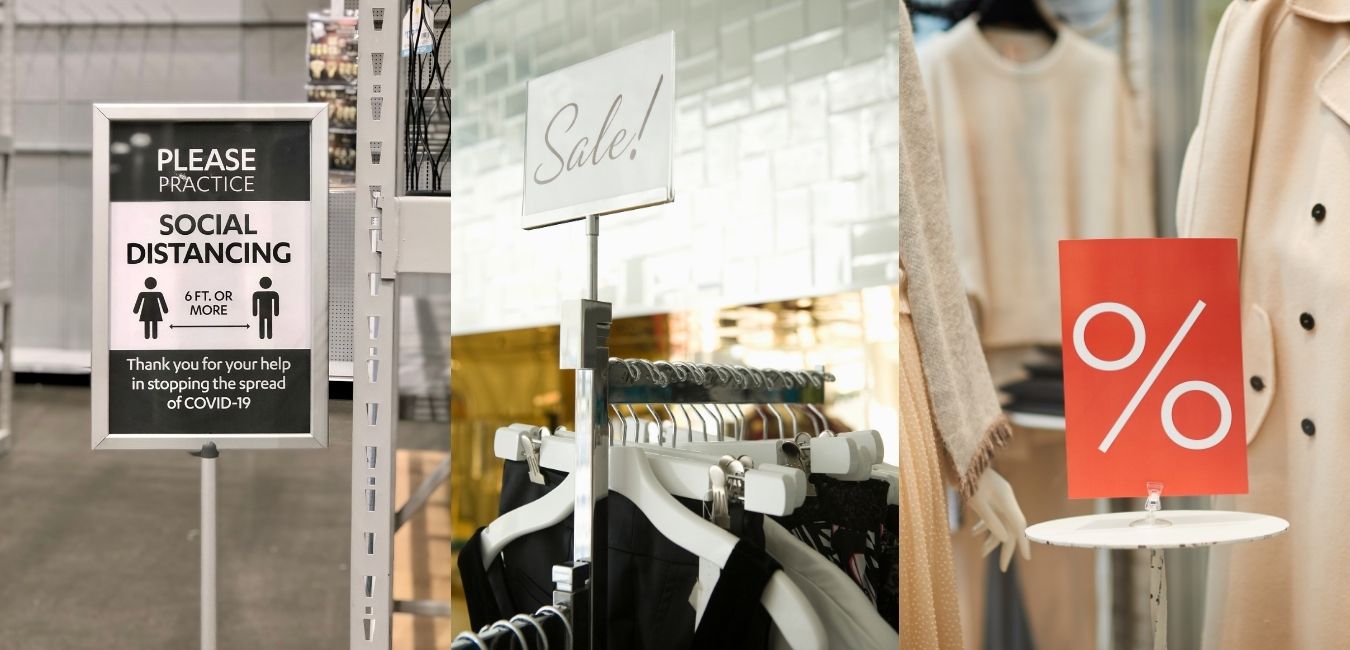In a digital age, does in-store signage still matter?
Article published on Mar 09, 2021
In a digital age, does in-store signage still matter?
In this digital world, it's easy to forget how many people still do their shopping in-store. Yes, online shopping increased greatly during the pandemic, but what might surprise you is that in-store spending actually increased as well. According to a study by Colliers Institute, in-store sales grew 2.2% in 2020, despite the pandemic and despite projections it would decrease by as much or even more. If you look at the data more granularly, certain industries saw even more growth than this with home goods growing 9% for example and grocery stores growing 12.5%.
With Americans still participating in traditional retail shopping, business owners should remember how important signage is for in-store sales. Even simple free-standing floor sings can make a big difference for customers and businesses alike.
Good signage can foster positive customer experiences by helping customers find what they're looking for
FedEx Offices conducted surveys in 2015 which suggested a few strong ways in which proper sign use increases sales and improves customer service. Their surveys indicated for example that 8 in 10 customers attribute their entry into brand to stores to the signs that store displays. 68% of the consumers surveyed also indicated that signs help them determine the quality of the products they'll find inside a store.
But perhaps more interesting are the results of recent sureys of Mellenial and Gen-Z shoppers sepcifically. According to recent data targeting these age groups, 62% of in-store shoppers said they prefer these off-line experiences because they value actually seeing and touching the items they're purchasing. Despite their digital lives, America's 20-30 year olds still want to see what they're buying, and this means being able to find what they're looking for.
Good signage like Point-of-purchase displays can increase sales by promoting spontaneous, unplanned purchases.
A point of purchase display (also called a POP display) is a free-standing display or sign which is positioned strategically in the path of the shopper, for instance at the store entrance, the checkout counter, or next to the product being advertised. They're often customized to be unique shapes, interactive, or seasonal, but they can include simple traditional floor signs as well.
Sign placements like this are especially important when considering 70% of shoppers do not make their decisions in advance, but rather in-store. Recent studies have put that number even higher, at 82%. Furthermore, these studies go on to assert that 16% of these spontaneous purchases come about because of sign placement.
Good signage keeps customers safe and socially distanced.
In the age of Corona virus, the importance of wayfinding, direction, and instructional signs are even more important than before. even before the pandemic, studies indicated that as many as 21% of customers returned from shopping trips feeling more stressed than before.
Floor signs not only help prevent customer confusion by clearly labeling checkout lines, but they also provide important messaging for 6 foot social distancing, mask mandates, or occupancy limits. Knowing what to expect goes a long way towards decreasing shopping stress.
A lack of good signage can cost sales and decrease customer satisfaction.
The same studies which highlight the many benefits of proper signage also demonstrate the negative effects of improper or insufficient in-store signage. More than 50% of the shoppers surveyed in the FedEx study referenced above indicated that misspelled or poor quality signs deterred their entry into a store, while 60% said that a total lack of signs deterred their entry into a new store.
Conclusion
Shoppers are venturing offline for their shopping so that they can see, touch, and feel the products they're buying, but also because they want an immersive shopping experience. Sometimes they're driven by the social aspect of shopping, or other times (as is the case for 18% of those surveyed here, they simply enjoy the in-store shopping experience.
But still 17% of them admit they're more likely to shop online. This means retail stores must pay close attention to the large and small ways they can improve customer experiences to keep shoppers coming back, or increase the sales they make when those customers do show up.
Everything helps and as illustrated above, good signage with free-standing signs at entryways, featured products, and checkout can go a long way.


 Barricades
Barricades
 Belt Barriers
Belt Barriers
 Wall Mounted Belt Barriers
Wall Mounted Belt Barriers
 Classic Stanchions and Ropes
Classic Stanchions and Ropes
 Plastic Stanchion Posts and Chains
Plastic Stanchion Posts and Chains
 Signage
Signage
 Traffic Control
Traffic Control
 Chain Link Fencing
Chain Link Fencing
